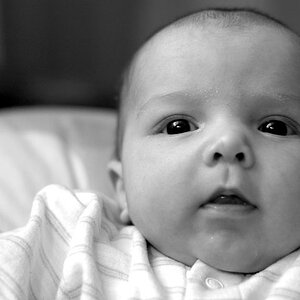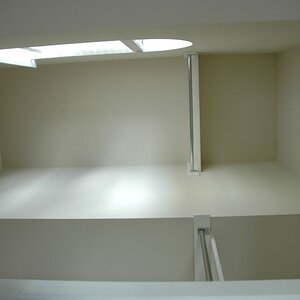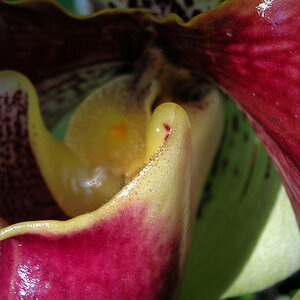Josh66
Been spending a lot of time on here!
- Joined
- Oct 31, 2007
- Messages
- 14,593
- Reaction score
- 1,239
- Location
- Cedar Hill, Texas
- Can others edit my Photos
- Photos NOT OK to edit
Could tap water cause developer to exhaust quickly after being mixed? Like, minerals in the water or something?
I seem to be having a lot of problems lately that I've never had before. The only thing I can think of is that my water is bad all of a sudden (I know they do change up the chemicals and/or amounts they use to purify it every now and then). I've tried everything else. All of my chemicals are fresh. I'm doing everything the same as I always have, and am just now having problems.
I have only been using distilled water for the final rinse in Photo Flo, but now I'm thinking that I may have to start using it for everything... I developed a roll of T-Max 100 (35mm) today in Rodinal (1+100, 1 hour stand) - I did use distilled water for that and it looks perfect.
Yesterday (edit - no, that was this morning...), though - I developed a roll of Acros (120) in HC-110 (B) using tap water, and I didn't even bother rinsing it, it was so bad. It went straight to the trash can. I have shot a lot of Acros, and used a lot of HC-110 before. I know it's not something I'm doing different than usual...
I mainly use Rodinal and HC-110, and sometimes Xtol. I have had issues (very thin negs) with all three recently, on multiple films in both 35mm and 120. The problem does seem worse on 120 though - I'm thinking that's just because the film is bigger. The Xtol is the only one that's mixed into a working solution, so I'm kinda scared to use it now, lol. I considered dumping it and buying a new kit (only $10).
Just to be safe, it's distilled water only from here out. I'll do more testing tomorrow to see if that fixes anything.
I just wanted to check if the tap water even can kill or greatly reduce the strength of a developer before I do too many more test rolls. I mean, is that even possible? I have never had issues using tap water before, but I don't know what else it could be...
Throwing film in the trash is getting old.
Just because I know someone will ask - it is not a metering problem. I'm using three different cameras, all of which have a meter, plus a hand-held light meter. All 4 meters are consistent with each other.
If it is the water, should I be worried (about drinking it, I mean)? What could be in it that would exhaust a developer?
I seem to be having a lot of problems lately that I've never had before. The only thing I can think of is that my water is bad all of a sudden (I know they do change up the chemicals and/or amounts they use to purify it every now and then). I've tried everything else. All of my chemicals are fresh. I'm doing everything the same as I always have, and am just now having problems.
I have only been using distilled water for the final rinse in Photo Flo, but now I'm thinking that I may have to start using it for everything... I developed a roll of T-Max 100 (35mm) today in Rodinal (1+100, 1 hour stand) - I did use distilled water for that and it looks perfect.
Yesterday (edit - no, that was this morning...), though - I developed a roll of Acros (120) in HC-110 (B) using tap water, and I didn't even bother rinsing it, it was so bad. It went straight to the trash can. I have shot a lot of Acros, and used a lot of HC-110 before. I know it's not something I'm doing different than usual...
I mainly use Rodinal and HC-110, and sometimes Xtol. I have had issues (very thin negs) with all three recently, on multiple films in both 35mm and 120. The problem does seem worse on 120 though - I'm thinking that's just because the film is bigger. The Xtol is the only one that's mixed into a working solution, so I'm kinda scared to use it now, lol. I considered dumping it and buying a new kit (only $10).
Just to be safe, it's distilled water only from here out. I'll do more testing tomorrow to see if that fixes anything.
I just wanted to check if the tap water even can kill or greatly reduce the strength of a developer before I do too many more test rolls. I mean, is that even possible? I have never had issues using tap water before, but I don't know what else it could be...
Throwing film in the trash is getting old.
Just because I know someone will ask - it is not a metering problem. I'm using three different cameras, all of which have a meter, plus a hand-held light meter. All 4 meters are consistent with each other.
If it is the water, should I be worried (about drinking it, I mean)? What could be in it that would exhaust a developer?
Last edited:






![[No title]](/data/xfmg/thumbnail/41/41899-007f14ae0d832ef200fd62eedc4da42e.jpg?1619739936)
![[No title]](/data/xfmg/thumbnail/41/41492-467958db3420bceb7ab410a12dcc681f.jpg?1619739819)

![[No title]](/data/xfmg/thumbnail/41/41901-789e8104ff95e5862c8f07611e3c34c0.jpg?1619739938)
![[No title]](/data/xfmg/thumbnail/40/40310-01bec1b9b7918522bf21a09cf75c5266.jpg?1619739414)
![[No title]](/data/xfmg/thumbnail/39/39443-45e1b162b6c7c1d8ebbc8faf5623b705.jpg?1619739034)

